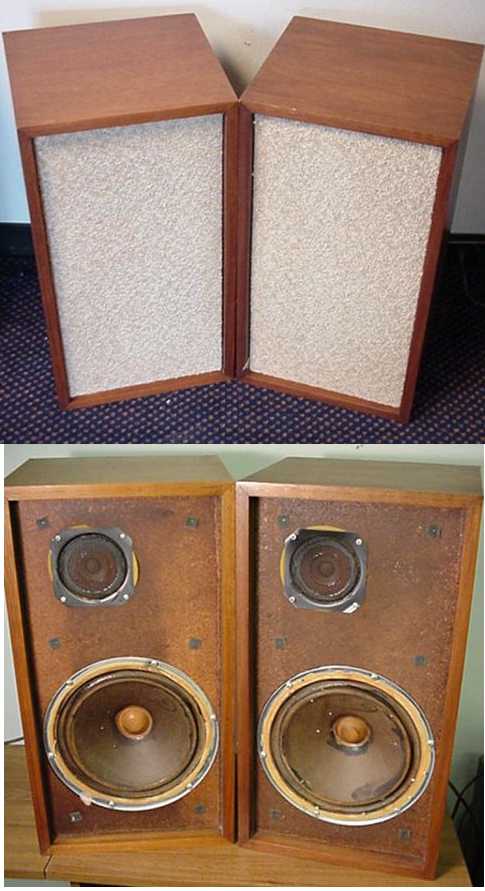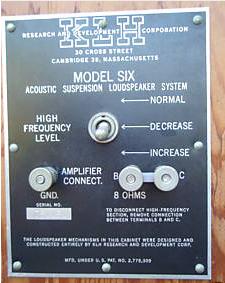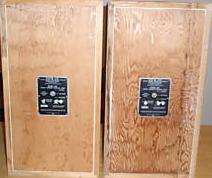English Knol Project
|
This article written by Will Johnson, wjhonson@aol.com
Today (12 Sep 2009) I picked up a pair of KLH Model Six speakers. They have a woofer and tweeter and the cabinets are made of a blond plywood, that appears to be 1" thick. The cabinets are 23 1/2" tall, 12 3/4" wide, and 11 3/4" deep. Apparently they originally came with a thin veneer covering, or at least some of these did, maybe they started adding the veneer on later year models. They're heavy, at least 25 pounds each, maybe up to 35. The name "KLH" stands for the principals in the company, the "K" is Henry Kloss (1929-2002). The serial numbers on the ones I have are 005259 and 005270.
Henry Kloss had a long history in speaker design. When Edgar Villchur, a teacher at New York University, designed a new type of loudspeaker, he and Henry Kloss founded Acoustic Research. Two other partners, Malcolm Low and J. Anton "Tony" Hofmann, supplied $5000 in capital. Thus was born the AR-1, the world's first acoustic-suspension loudspeaker system, with its relatively small enclosure and proportionally prodigious bass. (citation) Kloss, Low and Hofmann then founded KLH in 1957. Kloss later moved on to more fame by founding Advent in 1967. He left Advent, and in 1988 co-founded Cambridge Soundworks.
There is a forum devoted to discussing classic KLH speakers at this link.
Google search for KLH Model Six
Google search for KLH Model 6
 |
| Credit: Horswispr at epinions.com |
There is a review of these speakers at this link at epinions.com, written by Horswispr. In that review the picture on the left here is linked. The pair I picked up, do not have this finish. I understand that this is a veneer, not solid wood. The ones I have are quite clearly plywood cabinets. Could it be that someone merely removed the veneer covering? Or were the plywood models first and then "beautified" in later years?
The original manual for the Model 6 is at this link at classicspeakerpages.net There they state that these are an "8 ohm two-way loudspeaker system." They also state that the "low-frequency section is a twelve-inch acoustic suspension", and that this was (at that time) a new technique. They provided decent bass in a small enclosure if driven with enough power. Evidently "acoustic suspension" was created by building a small, inner box directly around the magnet behind the woofer. And then this is of course enclosed within the cabinet. I noticed something like this when I opened up my Wharfdale's as well. A box around the back of the woofer.
The manual continues by pointing out that the two speakers are permanently epoxied into the cabinet, and that the front panel is glued into the cabinet. So there is neither a simple way to get at the backside of the components, nor get into the back of the cabinet. You can see however in the picture at left, that the components are screwed in, so what's the deal? It turns out that at some point, KLH switched from glued-in components to screwed-in ones. The pair I have, have no screws. It's possible I have the very oldest pair still in working order in the world! (Hey, it's possible.)
Now let's mention the surrounds for a moment. They're weird.. what the heck? It turns out the surrounds are not rubber, they are not foam, they are cloth! That's right. So they are no maintenance? Never need to be replaced? Can't deteriorate? I'm not sure. But heck the pair I picked up are forty nine to fifty one years old and the surrounds are still just fine, and apparently original. So that's something.
These speakers were originally marketed in 1958 ("Billboard", 20 Oct 1958) and sold as well throughout the 1960s, the original grill cloths were that heavy beige-or-tan-colored material. I think many people over the years have redone the grill cloths. So that would mean ripping them out and rebuilding the frame, it's doubtful you could gingerly take the frame out intact. A site reader has informed me that later Model Sixes had removable screens and screwed-in components. The pair I picked up have black grill cloth. At least one seller states that his grills are removable, but its also possible that someone has redone them to make them removable. On mine, after I took the grill covers off, you can see strands of the original grill cloth still embedded behind the inner sidewalls. So evidently the cloth was put directly over the speaker components and then the entire assembly was glued into the cabinet as one piece. I suppose if you were very very patient, you could tweeze out all the strands of cloth but I mean, who does that?
The manual also clarifies the odd setup on the back where you have three terminals marked A, B, C instead of the more well-known two-terminal setup. The A terminal is also marked Ground, and the B and C terminals are joined by a tiny metal strap, called a "shorting strap". The reason for three terminals is to allow separate use of the woofer vs the tweeter. If you remove the shorting strap connecting terminals B and C you can then use terminals A and B for the woofer and A and C for the tweeter. If you leave the shorting strap intact, then you connect one stereo wire to A and the other wire to B. Not all Model Sixes had three terminals, some, clearly labeled as Model Six, had only the two standard terminals. Which came first? I don't yet know. But I bet it was the three terminal setup pictured here, because that's what mine have.
Another unusual feature of these speakers is the three-position switch on the back that adjusts the high-frequency response. The range of this effect is only 5dB. I really didn't notice much when I tried it. Either mine is broken or it just doesn't make that big of a difference.
This link is to one ad from Apr 2009 selling these for $100 for the pair with a picture.
Another ad from May 2009 selling these for $120
This link is to a pair up for auction on Ebay today (12 Sep 2009).
And another pair with a starting bid of $140 and a buy-it-now price of $245 !
But here's a pair in Las Vegas for only $50
Some more pictures and details from a Feb 2005 ebay listing, where the seller discusses that the binding plate was flush on some, and countersunk on others.
In the picture here you can see the binding plate flush on the back of the cabinets as it was originally made. Later models have the plate countersunk (embedded) into the wood.
My tweeter and woofer are both a golden color, apparently original equipment since you cannot open the cabinets without destroying them. Now after doing all this research, I'm suspecting that possibly the "plywood" cabinets I have (or whatever this material is), are actually the original cabinets the way they were first made -- without veneer. After all, my pair are only the 5,000th pair ever made! Perhaps, like other issues with the Model Six, they started with this, and after a while, decided to add veneer to later models.
On the back of mine, there is another strip of wood attached to two small pieces of wood and four hooks! Apparently these were made, or modified so they could hang. I removed that setup but now I'm wondering if I should have! Now I have about sixteen very tiny holes in the back of my cabinet. A little wood putty and a touch of sanding and those holes vanished!
My official audiophile tester just told me "I've heard dozens of speakers, but these are the best I've ever heard". So there you go. Of course later he decided that the Norman Labs speakers were the best he'd ever heard! So there's no telling.

